#dark rise c s pacat
Text



Will and Sarcean from Dark Heir by my favourite C. S. Pacat ❤️ If you want to see more of my drawings and support me, here is mine ig:@ninsy.art 🫶🏼
#c.s. pacat#cs pacat#dark rise#will kempen#fanart#dark heir#dark rise c s pacat#dark rise fanart#sarcean
207 notes
·
View notes
Text
Every time I think it cannot get possibly worse C.S. Pacat hits me in the gut with a bowling ball.
Help me, how long do I need to wait for book 3
#if you cannot tell#i finished dark heir#well and truly devastated#c s pacat#dark rise c s pacat#dark rise#dark heir#dark heir c s pacat#will kempen#james st clair#violet ballard#cyprian
95 notes
·
View notes
Text

He faced Will as if he saw in him a figure from long ago. A figure he served. A figure he knew.
‘You remember,’ said Will.
James looked back at him with the past in his eyes.
‘Sarcean. I remember everything.’
| Will Kempen and James St. Clair. | WIP #1
#im working on it so its not even near done but#dark rise#dark heir#c. s. pacat#will kempen#james st. clair#fanart#dark rise fanart#mine#art wip#there's no sign cuz i forgot to put it and mow im too lazy;; please don't repost it without my permission
412 notes
·
View notes
Text
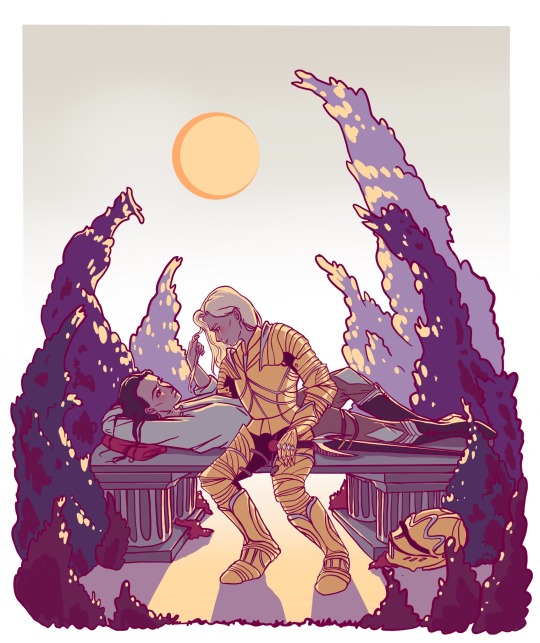
instead of finishing reading the book i spent the day drawing the sarcean and anharion hair touching in the garden scene which made me feel completely normal obviously
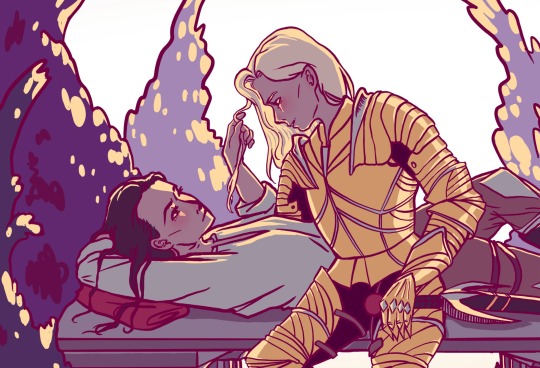
492 notes
·
View notes
Text

277 notes
·
View notes
Text

#artists on tumblr#dark rise#dark heir#violet ballard#will kempen#c. s. pacat#cs pacat#books#scenery art#fanart#art
381 notes
·
View notes
Text
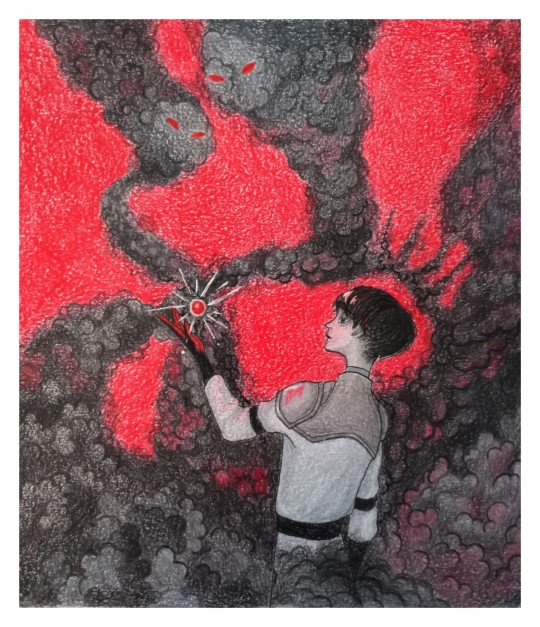
I endlessly love the moment with shadows from the book, and I wanted to draw it
253 notes
·
View notes
Text
The old language: the alphabet and some patterns
from the books Dark Rise by C.S.Pacat
----------- ✶ -----------
The old world holds many attractions for the readers: its mysterious history, culture, characters and language. There are inscriptions and phrases in old language in the books. At first glance, they look scary and inexplicable. Nevertheless, at second glance, the language opens up. In this analysis, I hope to show that the old language is amazing and share the delight I had researching it.
First of all, disclaimer. I am not a true linguist and, moreover, not Kettering, but a person who loves to find out patterns and tries to explain them. This article is just my theory, hypothesis and my point of view. It can be different from the canon.
There were phrases in the old language and their translations in the first edition of the Dark Rise. They inspired me to reconstruct the old language alphabet and to start my research. The inscriptions in the Dark Heir, the second book, proved the alphabet to be correct.
----------- ✶ -----------
The alphabet
As I have already mentioned, the alphabet is based on the translations of the old language in the first edition. I will use one phrase as an example to explain a deciphering algorithm. As I have applied the same algorithm to all inscriptions, I will only mention other phrases in the old language to show the letters they contributes to the alphabet.
The phrases from the Dark Rise: Decoding the alphabet
Step 1: selecting similar letters
Here is the phrase “Rassalon the first lion”.
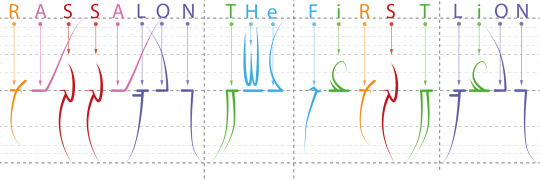
There are two S in “RaSSalon”; there is also S in “firSt”
Double S is between two A
The first word begins with R, and R is also present in“fiRst”
L — “Lion”
O —“liOn”
N — “lioN”
“...the First Lion”
T — in “The” and “firsT”
i — in “first” and “lion”
!(why “i” is small I am going to explain later)!
Step 2: non-repeating letters
New letters: H, e (!) and F.
Other phrases
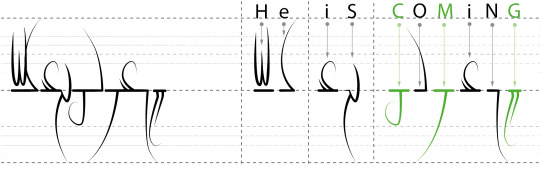
He is coming (Dark Rise, chapter 11)
New letters: C, M, G
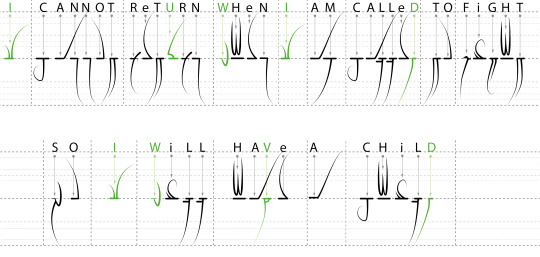
I cannot return when I am called to fight So I will have a child (Dark Rise, chapter 2)
New letters: U, W, D, V, I(!)
I and i are different. In my opinion, it might be because “I” is a pronoun.

Enter only those who can (Dark Rise, chapter 15)
New lettres: Y, E
E and e are different. Perhaps, it is because “E” is in the beginning of the word “Enter”.
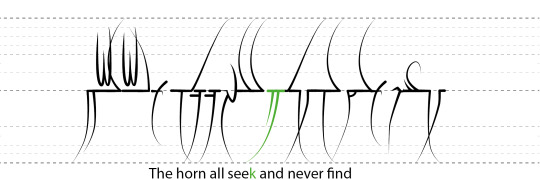
The horn all seek and never find (Dark Rise, chapter 15)
The new letter: K
Note: The letter design in the figures is a little different from the original design due to qualities issues.
The phrases from the Dark Heir: Proving the alphabet relevance
There are also inscriptions in the Dark Heir. If I use the same strategy here, it does, here are the proofs.
The first proof
One of the inscriptions is the name Undahar. Names are not translated. All letters in Undahar match the letters of my alphabet except U. It turns out to be V in the previous inscriptions, so I will write two variants U/V because I am not sure which one is correct.
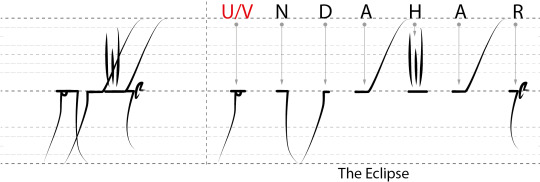
The Eclipse/Finem Solis (Dark Heir, chapter 26)
The second proof
Here is the phrase: “He is coming.”
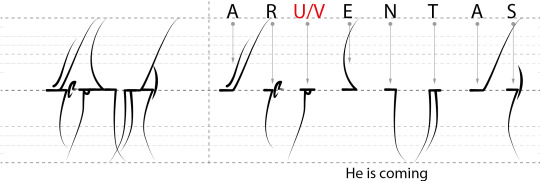
(Dark Heir, chapter 2)
Although there is one unknown letter, we can identify it by using the similar phrase:
He is fighting — Ar ventas
He is coming — *r uentas/ventas
The new letter is A. I think this A is different from the regular A because it is the first letter of a pronoun. Pronouns start with capital letters to avoid confusion with other words that include “ar”.
The result: alphabet
Of course, I admit the possibility that not all letters comply with the original alphabet as it is in the U/V case.
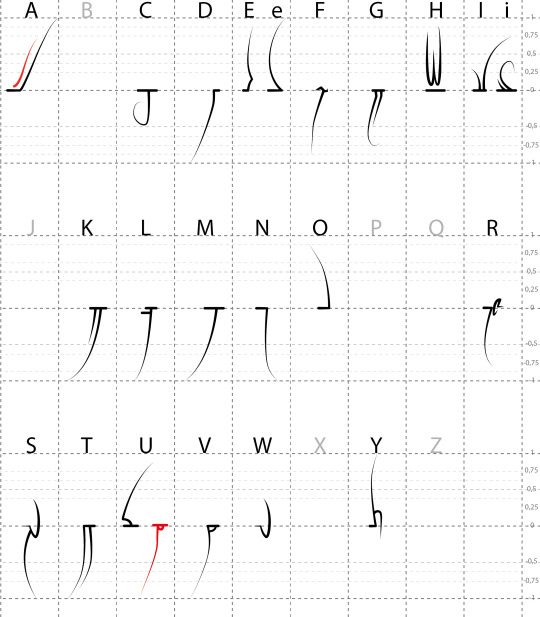
Issues in deciphering
The same phrases in the old language are written differently in the Dark Rise and the Dark Heir. I do not know whether it is due to errors in the first two editions or it means something else.

He is coming, Dark Rise (chapter 11), edition 2021

He is coming, Dark Rise (chapter 11) edition 2022
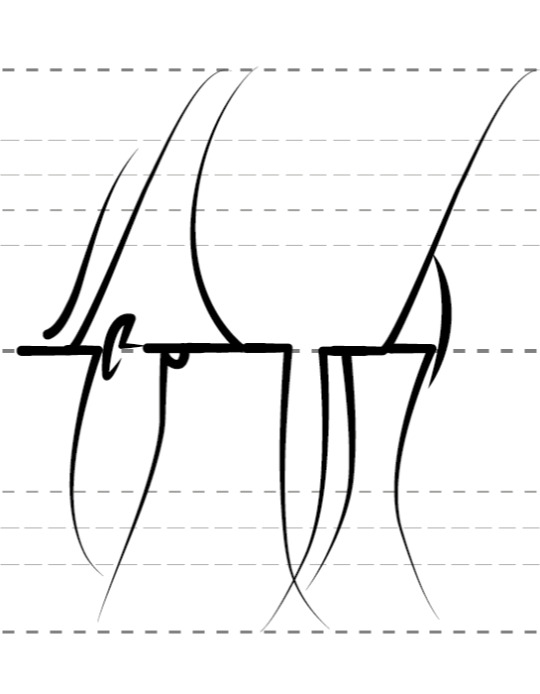
He is coming, Dark Heir (chapter 2)

The past cries out, but the present cannot hear, Dark Heir (chapter 2)

Only a Steward may enter, Dark Heir (chapter 37)

Dark Rise (chapters 2, 10, 11, 15), edition 2021
----------- ✶ -----------
The structure of the language
There is more to the old language than the inscriptions. Here are my thoughts on the other aspects of the old language. The old language is likely to be the parent language to all languages in the books, the language from which modern languages have derived. The old language has similarities to Latin and Sanskrit, borrowings from Sindarin, Quenya and some unidentified languages.
Vocabulary
Analyzing new information, I have found patterns that helped me to identify word classes. The word classes of the old language are shown in the table below.

Data summary sheets
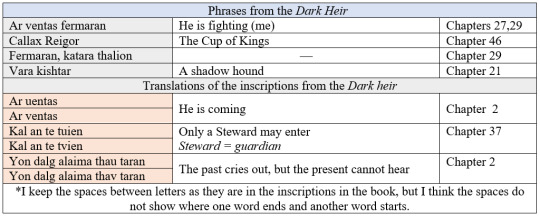
----------- ✶ -----------
Nouns and names
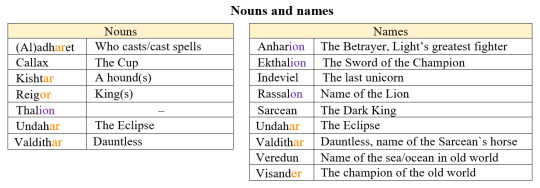
Most nouns end with “ar”, but there are two nouns that end with “or/er”. The pattern is pretty apparent, so I am going to discuss only the nouns that do not fit the pattern.
Aladharet and adharet
My suggestions about meanings and forms of the word “adharet” are based on this dialog:
‘He said, ‘I am not aladharet.’ <...>
‘I cannot do magic,’ he said. ‘I have never trained with the’ – there was no other word for it – ‘adharet.’ <...>
‘I only know what I have seen, watching the adharet cast spells as I fought to protect them.’ (Dark heir, chapter 38).
There are two variants of the word: aladharet is singular and adharet is plural. Perhaps, “al” is the marker of a singular form, I would no more touch on single/plural forms because we do not have enough information.
The closest meaning from the context is a wizard /enchanter. This noun is interesting because “ar” is in the middle of the word. I think it is a verbal noun (a noun derived from a verb), such as spell – speller, enchant – enchanter.
Kishtar
According to the book, “Vara kishtar” is a shadow hound. “Kishtar” is highly likely to mean a hound or hounds. (Chapter 21)
The root “Kisht” means field, sown-field, tillage, cultivation, (at chess) check in Sanskrit. Of course, the meaning of the word in the old language is different, but it is still quite an interesting coincidence.
Similarities to Latin
There are some Latin names in the books like “Finem Solis”. Besides, some words in the old language are very similar to Latin (see the examples below).
“Callax Reigor” (The Cup of Kings) (Chapter 46)
“Callax” reminds Latin “Calix” (the Cup).
Reigor (Kings)
The root “reig” resembles the Latin root “reg” in “regio,-are”, “regium” (to rule/ royal).
Valdithar
English translation is “dauntless”, it is the name of Sancean`s horse. It has the ending “ar”, probably, because this adjective plays a role of a noun as abstract adjectives can be nouns in English. Synonyms of the “dauntless” are valorous, valiant. They derived from the Latin word “valens” – strong, powerful. This meaning of “val” seems to be suitable for Valdithar as well.
Similarities to Tolkien`s languages: Sindarin and Quenya
As some readers know, C.S.Pacat is a big fan of the J.R.Tolkien, so I decided to compare Tolkien`s languages with the old language and found out some borrowings from them. Several names look like Elvish words in which some letters are altered.
The ending “ion” is typical to Elvish.
Anharion
He is the Light’s greatest fighter who served the Sun King. That name consists of two parts: “Anar” is the Sun and “ion” is a son in Elvish. The sound “h” is pronounced with exhalation, so it might be omitted. Anharion means the son of the Sun in this case. In addition, the name was given to him by the Light side (the Sun King) and it is not his true name.
Ekthalion/thalion
Ekthalion is the Sword of the Champion.
Although “Fermaran, katara thalion” (Dark Heir, chapter 29) does not have a translation, “thalion” is a hero/a dauntless man in Sindarin. In my opinion, the coincidence is not an accident. “Thalion” is the part of the Sword`s name and the meaning seems relevant in context of the books.
Moreover, Ecthelion`s fate in the Silmarillion is quite similar to the fate of the Sword. Ecthelion slayed Gothmog, Lord of Balrogs, at the cost his life. The Sword`s fate is described in the book as follows:
…As a weapon to kill the Dark King. It’s said that a great Champion of the Light rode out with it to fight him <…> but could do no more than draw a single drop of the Dark King’s blood. That’s all it took to corrupt the Blade… (Dark Rise, chapter 13).
The name Ecthelion had its own evolution: its Qenya cognate was Ektelion.
Another thing
Veredun
One of the characters mentioned this name in the following dialog:
‘This isn’t my first time at sea.’ Visander <…>.
‘Atlantic? Pacific?’
‘The Veredun,’ said Visander.
He looked out at the night expanse of black water. This did not feel like the Veredun, or like any sea he had known (Dark Heir, chapter 34).
Names are not translated, but I wanted to know more about this old world sea/ocean. There is no word which is exactly the same in any language relevant to my research, but there are analogs to its parts.
Vere/verus is “truth” in Latin
Dun is “dark/deep/gray/gloomy” in English
Dun is “West” in Sindarin
My translation is “The deep truth” or “The dark truth” or “The West truth”, but I do not pretend to know the truth.
Verbs

All verbs that we know end with “as”.
Aragas
Aragas means “open” in the old language. I have not found any Latin roots. However, separate parts of this word exist in Sindarin: “ara” is “royal” and “gas” means a hole/gap/opening. Aragas is used for opening gates that connected the Kingdoms, for opening the oubliette under the Sun King`s throne and in the metaphor of opening the door of the Dark King`s magic. All these cases are associated with something “royal” and “opening”. I might have gone a bit too far here and read too much into it.
Ar ventas
Ar ventas – He is fighting (The translation from the text, Dark Heir, chapters 27, 29)
Ar uentas/ventas – He is coming (The translation of the inscription, Dark Heir, chapter 2)
There is a possibility that these verbs are borrowed from Latin. The root of the word “uent” is the same as in the Latin verb “uenio/venio” (to come). Thus the ending “as” indicates a tense and a person (is coming). My guess is that V and U are interchangeable in Latin. Therefore, “ventas” means “is coming” and “is fighting” at the same time. I think “uentas” is right, because U turns into V.
Vala!
One of the characters used this word in the following dialog:
With a tug of her horse’s mane, she [Visander] said something that sounded like Vala!, and they burst out of the stable doors (Dark Heir, chapter 21).
I think it is the command “walk/run” for a horse and the verb could be in the imperative mood. In my opinion, there is a parallel to Latin. Singular imperatives are formed by removing the ending “re” from verb roots, for example, monstra̅re (to show) – monstra (show). Nevertheless, “Vala!” could be another command, e.g. “gallop/forward/ahead”.
Adjectives
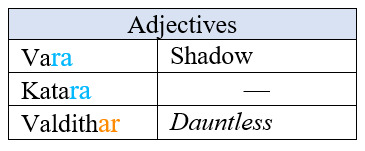
I think the ending “ra” indicates adjectives. Valdithar looks like an exception, but I think it is not an exception because it is a noun (see the section about nouns).
Vara
The translation of “Vara kishtar” given in the books is “a shadow hound” (Dark Heir, chapter 21).
It also means “soiled” and “dirty” in Quenya. As far as we know, “Vara kishtar” is a creature of the Dark side, and all shadow creatures could be “soiled” in the Light side`s opinion. By the way, there is the Sanskrit word “vara” that means “the best, excellent, the eldest”. The meaning is opposite to the meaning in the old language, but the Dark side could use the word differently.
Katara
“Fermaran, katara thalion”(Dark Heir, chapter 29).
Katara ought to be an adjective because it ends with “ra” and because of its position in the sentence (before a noun). The text does not give a translation, so I decided to consult dictionaries.
Latin and both Elvish languages did not help, but Sanskrit has the adjective “katara”. It has several meanings:
Which (of the two)
Mean, poor, miserable
Timid, shy/cowardly, cowardly/fearful
I have never mentioned Greek before, but it also contains “katara”, but as a noun: κατάρα is a curse or a calamity/disaster.
----------- ✶ -----------
Other observations
I noticed other patterns as well, but I need more examples to confirm them.
Structure of sentences
Like in English, a subject goes before a predicate:
Ar ventas – He is fighting
Ar uentas – He is coming
An adjective precedes a noun:
Vara kishtar – a shadow hound
Katara thalion – a shy hero (?)
My own hypothesis
Old language adjectives agree with nouns in gender, case and number.
There is evidence that verbs conjugate and have different tenses. So far I managed to identify only one verb form (continuous, third person, singular). I suppose that the inscriptions contain other verbs as English translations provide other verb forms including modal verbs, various tenses and person.
The reconstructed translation
Only one phrase from the Dark Heir has no translation: “Fermaran, katara thalion” (Dark Heir, chapter 29). We know the hypothetical meanings of the words from the analysis, so the translation might be reconstructed.
Fermaran
Ar ventas fermaran (Chapter 27)
Ar ventas, fermaran (Chapter 29)
In this case, “fermaran" is not used to address someone because there is a variant without a comma. Catalan has the verb “fermar”. It means “to stop”. The form “fermaran” is “they will stop” in indicative future, plural, third.
The reconstructed phrase goes as: “They will stop, mean/timid/poor hero”. It can fit in the context but it is still pretty questionable.
Inscriptions
Unfortunately, I have not achieved my goal to identify words in the inscriptions from the Dark Heir. As I mentioned there is not enough data. For example, the words we know from the translations such as the adverb “only”, the negation “cannot”, the modal verb “may” and the English phrase verb “cries out” remain unidentified. These inscriptions are still the Phaistos disc:

The past cries out, but the present cannot hear (Dark heir, chapter 2)

Only a Steward may enter (Dark heir, chapter 37)

Dark Rise paper editions 2021-2022
----------- ✶ -----------
The conclusion
Roots of the old language lie in Latin, Sanscrit, Sindarin/Quenya and, perhaps, something else. Four Kingdoms, four language families: Latin for the Sun/Undahar, Sanskrit for the Serpent or the home of the Lions, Elvish or unknown one for the Tower or the Rose.
I hope the third book will provide new data that will allow me to decode all inscriptions and get more profound understanding of the old language. Meanwhile, I am going to entertain myself with guesses, theories and attempts to decode the inscriptions.
----------- ✶ -----------
Acknowledgements
I would like to express my thanks to my aunt for being my editor, for all help and discussions about the old language, to my sister for all figures and to my friends from Undahar for the support and help! Thank you all very much!
All information is from the Dark Rise, the Dark Heir and dictionaries: Latin, Sanskrit, Sindarin and Quenya.
----------- ✶ -----------
The article also was written for the C.S.Pacat fanbook "Undahar" made by people from the discord server Undahar.
Please, credit me if you want to share the analysis.
85 notes
·
View notes
Text
Dark Rise characters as text posts ->
James:

Will:

Violet:

Elizabeth:

Cyprian:

Katherine:

105 notes
·
View notes
Text
sarcean literally said: when your circle is small but you fcked all of them
#i too would come back from death for him yk#like i get them#dark heir was actually a comedy if you think about it#dark heir#dark rise#will kempen#sarcean#anharion#james st clair#will x james#the lady#c s pacat#violet ballard#dark rise spoilers#dark heir spoilers
134 notes
·
View notes
Text


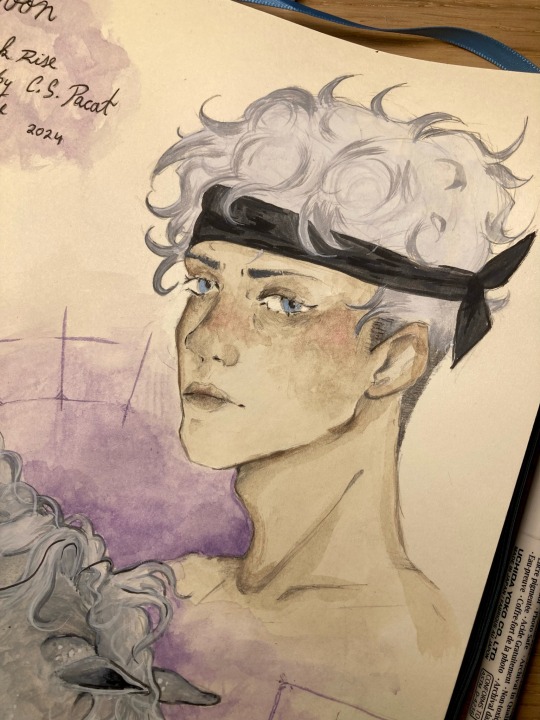
My version of Devon from Dark Heir by C. S. Pacat.
I love it and I hope we get to know more about our unicorn boy in the next book❤️
Ig:@ninsy.art
65 notes
·
View notes
Text
Just read the prologue and first chapter that were released to tease dark heir. Help me I made a mistake I can't wait for November.
#if i disappear after November 14 y'all will know why#i dont think i have the ability to survive this book#dark heir#dark rise#dark rise c s pacat#c s pacat
18 notes
·
View notes
Text
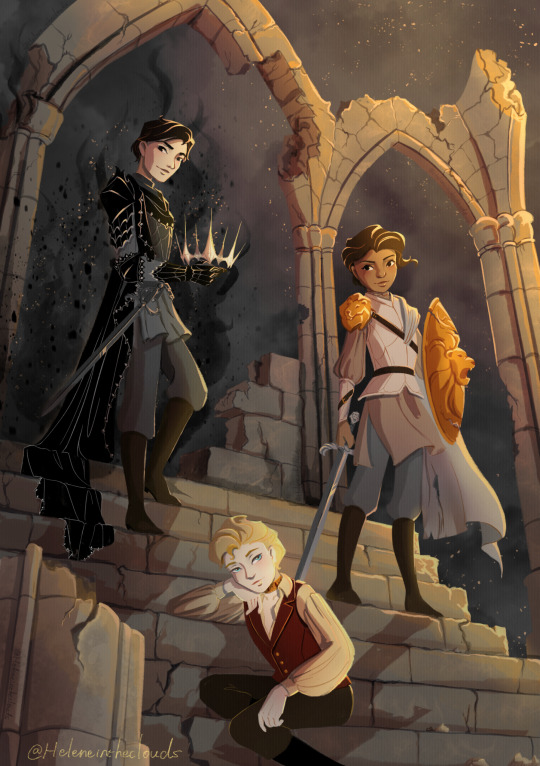
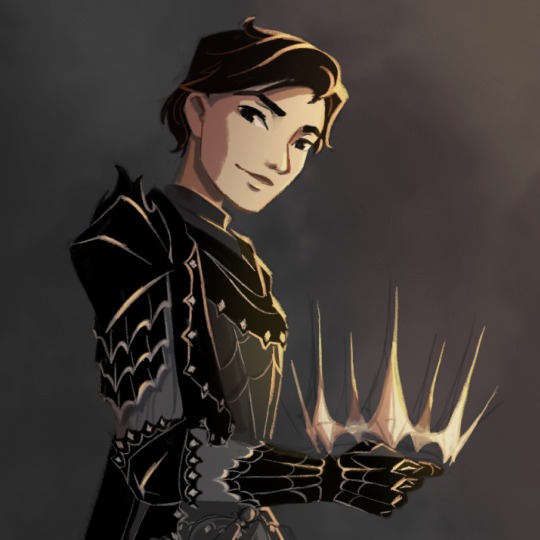
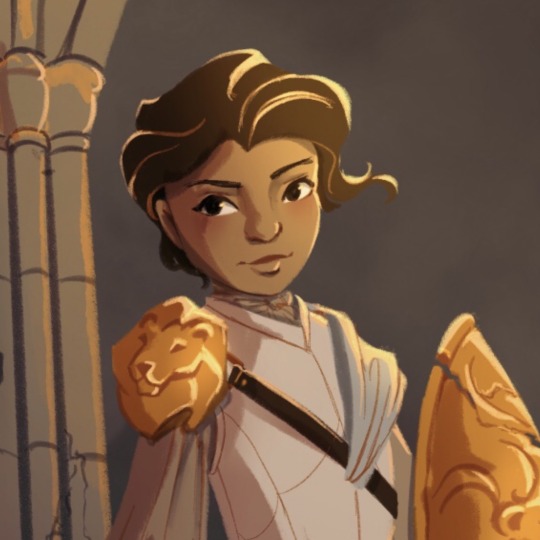
Dark Rise by CS Pacat Instagram
These three are assigned 'evil' for reasons they did not choose, (the same way queer people did not choose their identity) and I love the dramatic irony of this book so much
996 notes
·
View notes
Text
im halfway through Dark Heir and it rules, Pacat does it again - but every time they talk about the S tattoos this is what im thinking

275 notes
·
View notes
Text
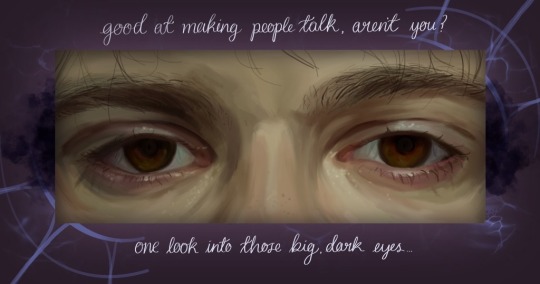
finished reading dark heir by C.S. Pacat and was so unwell about it that I painted one of my favourite lines
91 notes
·
View notes
Text

Will from CS Pacat’s INCREDIBLE Dark Rise trilogy
#dark rise#cs pacat#dark heir#dark rise fanart#dark heir fan art#c s pacat#dark rise fan art#will kempen#will kempen fan art#c s pacat fan art
93 notes
·
View notes